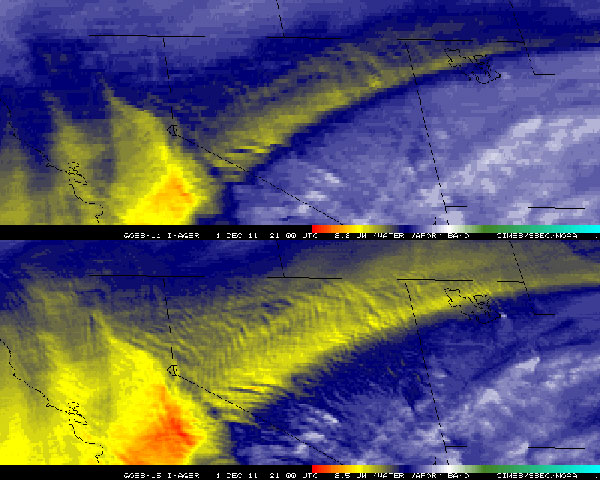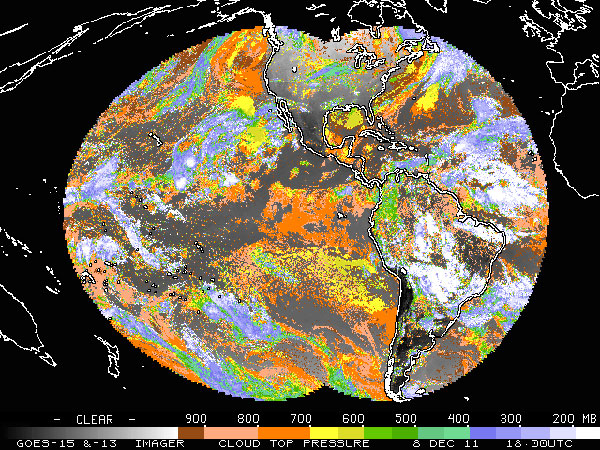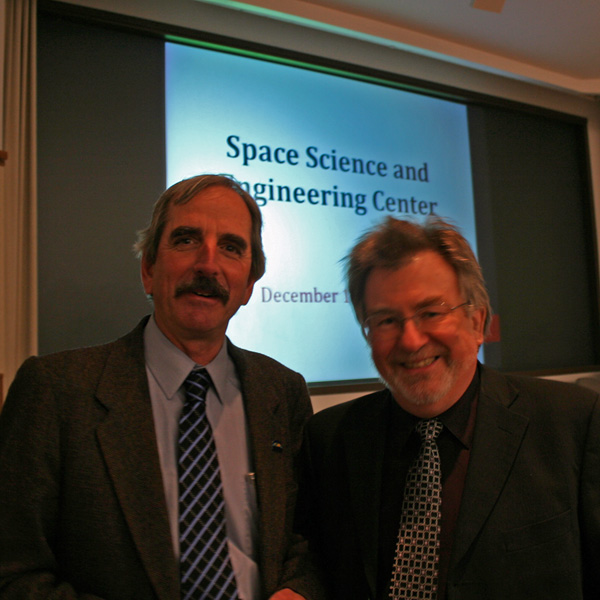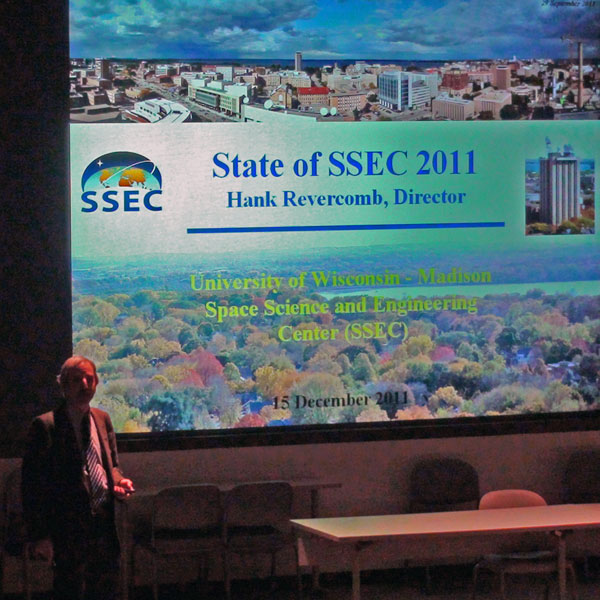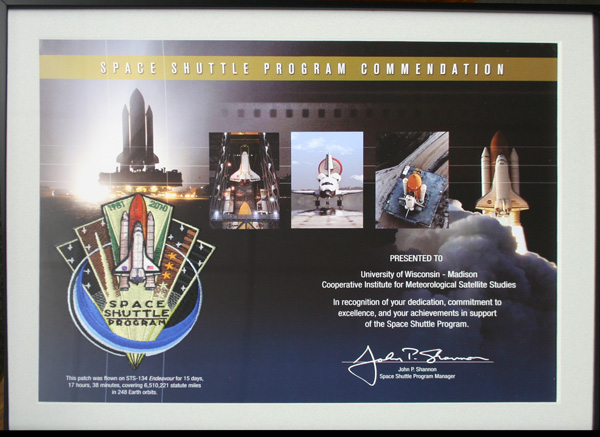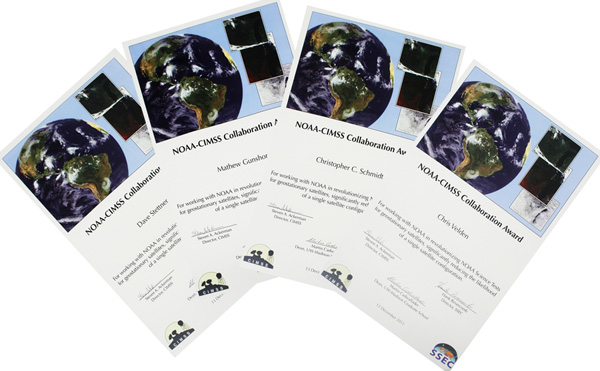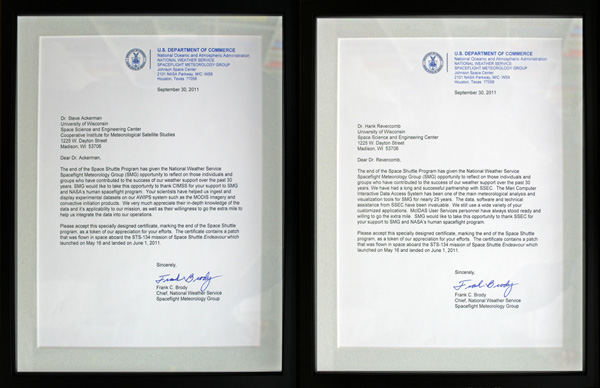Monthly News Summary – January 2012
- GOES-15 Imagery AWIPS Test
- GOES-15 Becomes Operational
- Arctic Report Card 2011 is Available
- State of the Center Address – 2011
- Awards Season at CIMSS
- Mobile Weather Alerts Highlighted on AMS Blog
Prior to the Geostationary Operational Environmental Satellite (GOES)-15 becoming operational on 06 December 2011, NOAA conducted an end-to-end test on 29 November which briefly substituted GOES-15 for GOES-11 as the source of GOES-West satellite imagery.
Using the Advanced Weather Interactive Processing System (AWIPS) and N-AWIPS software packages, the Cooperative Institute for Meteorological Satellite Studies (CIMSS) monitored the flow of GOES-15 imager and sounder imagery from the test facility.
Image of GOES-11 (top panel) and GOES-15 (lower panel). The improved spatial resolution for the mid-level water vapor band is evident. Both images are from 21 UTC on 01 December 2011.
More information, including select animations of visible and water vapor imagery before and after the temporary switch-over, can be found on the CIMSS blog archives.
At 15:45 UTC on 06 December 2011, Geostationary Operational Environmental Satellite (GOES)-15 replaced GOES-11 as the operational GOES-West satellite. GOES-11 (launched in 2000, and operational since 2006) was one of the older GOES-I/M series of satellites.
Compared to GOES-11, GOES-15 has:
- improved water vapor channel (Imager channel 3);
- slightly different visible channel (Imager channel 1);
- 13.3 µm IR (Imager channel 6) replaces the 12.0 µm IR (Imager channel 5) and
- improved Image Navigation and Registration (INR).
Examples of some of these GOES-11 vs GOES-15 changes before and after the switch-over can be found at the GOES blog archives.
With the operational insertion of GOES-15 (and the inclusion of the 13.3 um micron band) as the western geostationary satellite, both GOES-East and GOES-West Imagers are capable of generating cloud top pressures for both opaque and semi-transparent clouds using the same algorithm.
Material was also supplied for a “GOES-15 Becomes GOES-West” training session for National Weather Service (NWS) forecast offices. Tim Schmit and Scott Bachmeier participated in the first training lessons that were offered during the week of the satellite transition.
Arctic Report Card 2011 is Available
The NOAA Arctic Report Card for 2011 is now available. Jeff Key and Yinghui Liu (CIMSS) contributed to the “Temperature and Clouds” section. The Arctic Report Card provides clear, reliable and concise environmental information on the current state of the Arctic relative to historical time records. It is intended for a wide audience, including scientists, teachers, students, decision-makers and the general public.
State Of the Center Address – 2011
On 15 December 2011, Hank Revercomb gave his annual State of the Center Address to a capacity crowd at the Educational Science Building. Graduate School Dean Martin Cadwallader provided opening remarks.
Director Revercomb’s State of the Center address (as well as previous addresses) is available for download online in Powerpoint format.
UW-Madison CIMSS received the Space Shuttle Program Commendation from the Space Shuttle Program Manager:
NOAA-CIMSS Collaborations Awards were presented to Mathew Gunshor, Anthony J. Schreiner, James P. Nelson III, A. Scott Bachmeier, Dave Stettner, Steve Wanzong, Christopher C. Schmidt, Wayne Feltz, Justin Sieglaff, William Straka, Chris Velden and the SSEC Data Center:
And Steven Ackerman (CIMSS) and Hank Revercomb (SSEC) each received certificates from the National Weather Service Spaceflight Meteorology Group (SMG). CIMSS was recognized for uses of MODIS imagery to support NASA’s human spaceflight program. SSEC was recognized for McIDAS, a mainstay meteorological analysis and visualization tool for 25 years.
These awards and certificates, and much more, are on display in the Schwerdtfeger Library on the 3rd Floor of the AOS Building.
Mobile Weather Alerts Highlighted on AMS Blog
Mobile weather alerts was a topic featured on the American Meteorological Society (AMS) blog site. The article referenced an upcoming presentation at the AMS conference in New Orleans by Dave Santek (on 23 January 2012) that will show custom interfaces for smartphones that offer near real-time weather alerts.

